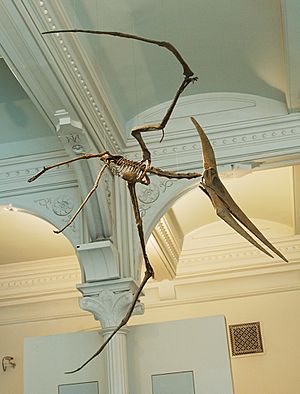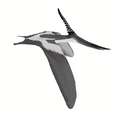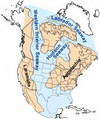Pteranodon facts for kids
Quick facts for kids PteranodonTemporal range:
Late Cretaceous |
|
|---|---|
 |
|
| A model of an adult male P. longiceps skeleton, AMNH | |
| Scientific classification |
|
| Kingdom: | Animalia |
| Phylum: | Chordata |
| Order: | †Pterosauria |
| Suborder: | †Pterodactyloidea |
| Family: | †Pteranodontidae |
| Subfamily: | †Pteranodontinae Marsh, 1876 |
| Genus: | †Pteranodon |
| Type species | |
| †Pteranodon longiceps Marsh, 1876
|
|
| Other species | |
|
|
| Synonyms | |
|
|
Pteranodon was a huge flying reptile, a type of pterosaur, that lived during the Upper Cretaceous period. Scientists have found about 1200 pieces of Pteranodon skeletons. This is more than any other pterosaur! It lived in an area called the Western Interior Seaway, which was a large inland sea that covered parts of North America.
Fossils of Pteranodon have been discovered in places like Kansas, Alabama, Nebraska, Wyoming, and South Dakota. These finds help us learn about where these amazing creatures lived long ago.
What Did Pteranodon Look Like?
Pteranodon was truly enormous. When its wings were fully spread, they could measure up to 6.25 meters across. That's longer than a small car!
Scientists think Pteranodon might have lived a lot like an albatross. It probably spent much of its time flying over the ocean, searching for fish to eat.
One of the most interesting things about Pteranodon is that it had no teeth in its long mouth. Instead, it had a small pouch, similar to a pelican, at the back of its jaw. This pouch was likely used to scoop up and hold fish.
Pteranodon also had a very noticeable crest at the back of its head. There were two main types of Pteranodon with different crests:
- Pteranodon longiceps had a straight crest that pointed backward.
- Pteranodon sternbergi had a larger, flatter crest that pointed upward.
How Did Pteranodon Live?
Pteranodon mostly lived in offshore rookeries. These were like big colonies, probably on islands or cliffs far out at sea. Most Pteranodon fossils are found in areas that were hundreds of kilometers from the coastline back then. This suggests they were true ocean dwellers.
They definitely ate fish. Scientists have even found fossilized fish bones in the stomach area of one Pteranodon fossil! Other fossils show tiny pieces of fish scales and vertebrae (backbones) near the body. This is strong evidence of their fishy diet.
Female Pteranodon were smaller than the males. They also had smaller, more rounded crests. The crests were probably used for showing off to other Pteranodon, maybe to attract a mate. However, they might have had other uses too, like helping with balance during flight.
Images for kids
-
A map of North America during the mid-Cretaceous period, showing the Western Interior Seaway (middle to upper left).
-
A P. longiceps skeleton in a launch pose, at Telus World of Science, Vancouver.
See also
 In Spanish: Pteranodon para niños
In Spanish: Pteranodon para niños













